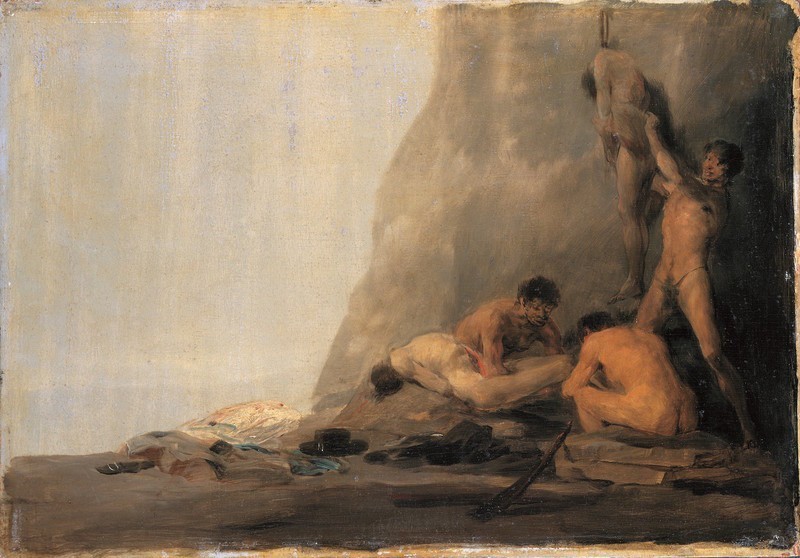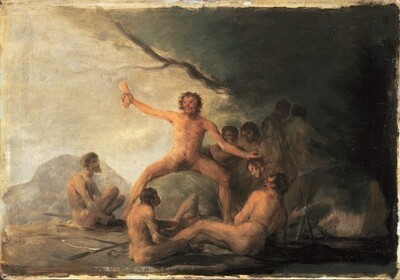- Cronología
- 1798 - 1800
- Ubicación
- Musée des Beaux- Arts et d’ Archéologie de Besançon, Besançon, France
- Dimensiones
- 32 x 46 cm
- Técnica y soporte
- Óleo sobre madera
- Reconocimiento de la autoría de Goya
- Documented work
- Titular
- Musée des Beaux-Arts et d’Archéologie de Besançon
- Ficha: realización/revisión
- 12 May 2010 / 15 Jun 2023
- Inventario
- (896.1.176)
- Otros títulos:
-
The Death of the Archbishop of Quebec (La muerte del arzobispo de Quebec)
The Jesuits Brebeuf and Lallemant Martyred by the Iroquois (Los jesuitas Brebeuf y Lallemant martirizados por los iroqueses)
Cannibalistic Episode (Episodio de canibalismo)
This work and its companion piece, Cannibals Contemplating Human Remains, belonged to the painter Jean François Gigoux (Besançon, 1806-Besançon, 1894), who bequeathed them to the Musée des Beaux-Arts et d'Archéologie in his home town.
In this painting we see a group of three cannibals as they prepare the bodies of their victims in order to eat them. One of the cannibals has his hand in the guts of one cadaver whilst another is skinning the body of a man hanging above the group. Both bodies have been stripped of their clothes, which we can see scattered across the ground.
The way in which the scene depicts human anatomy is particularly striking. The bodies which are about to be devoured are naked, deprived of all dignity, yet so are those of the cannibals, in this case in allusion to their primitive state.
It is fairly likely that Goya would have known the story of the Jesuit missionaries Jean de Brebeuf and Gabriel Lallemant, murdered by Iroquoi tribespeople in Canada in 1649 and then eaten by cannibals. This story could have been what inspired this work by Goya, in which the artist has resorted to his own imagination in order to recreate this scene of cannibalism. Goya thus continued with the reflections which he initiated in the works painted in Cádiz in around 1793, in which he started to explore some of the deeper and at times more shameful corners of the human mind.
In these paintings about cannibalism, the Aragonese artist looks at the most irrational part of man, and in so doing gives a foretaste of Théodore Géricault's (Rouen, 1791-Paris, 1824) famous take on this same subject, The Raft of the Medusa (1818, Musée du Louvre, Paris).
-
Peintures de Goya des collections de FranceMusée de l’OrangerieParís1938cat. 14
-
GoyaMinistry of Foreing AffairsBurdeos1951organized by the Bordeaux City Hall, consultant editor Gilberte Martin-Méry. From May 16th to June 30th 1951cat. 27
-
GoyaPrado National MuseumMadrid1951July 1951cat. 11
-
De Tiépolo à GoyaGalerie des Beaux-ArtsBurdeos1956consultant editor Gilberte Martin-Méry. From May 7th to July 31st 1956cat. 121
-
cat. 23
-
Goya and his timesThe Royal Academy of ArtsLondon1963cat. 66cat. 103
-
GoyaKoninklijk Kabinet van Schilderijen MauritshuisThe Hauge1970organized by Ministerio de Estado y Asuntos Culturales and Réunion des Musées Nationaux, July 4th to September 13th 1970. Exhibited also at the Musée de l’Orangerie des Tuileries, Paris, October 25th to December 7th 1970, consultant editors Jeannine Baticle and A. B. de Vriescat. 23
-
Goya. El Capricho y la Invención. Cuadros de gabinete, bocetos y miniaturasMuseo Nacional del PradoMadrid1993from November 18th 1993 to February 15th 1994. Exhibited also at the Royal Academy of Arts, London, March 18th to June 12th 1994 and The Art Institute of Chicago, Chicago, July 16th to October 16th 1994, consultant editors Manuela B. Mena Marqués and Juliet Wilson-Bareaucat. 82
-
Goya en tiempos de guerraMuseo Nacional del PradoMadrid2008consultant editor Manuela B. Mena Marqués, from April 14th to July 13th 2008cat. 24
-
Goya y el Mundo ModernoMuseo de ZaragozaZaragoza2008organized by the Fundación Goya en Aragón at the Museo de Zaragoza, consultant editors Valeriano Bozal and Concepción Lomba Serrano. From December 18th 2008 to March 22nd 2009cat. 151
-
Agen2019cat. 11
-
GoyaBasle2021p. 154
-
Vie et ouvre de Francisco de GoyaParísOffice du livre1970p. 263, cat. 922
-
BarcelonaPolígrafa1970vol. I, pp. 322 y 323, cat. 475
-
L’opera pittorica completa di GoyaMilanRizzoli1974p. 117, cat. 408
-
Goya. El capricho y la invención. Cuadros de gabinete, bocetos y miniaturasMadridMuseo del Prado1993pp. 288, 289 (il.) y 290, cat. 82
-
Goya y el Mundo ModernoZaragozaFundación Goya en Aragón y Lunwerg2008p. 271 (il.), cat. 151

